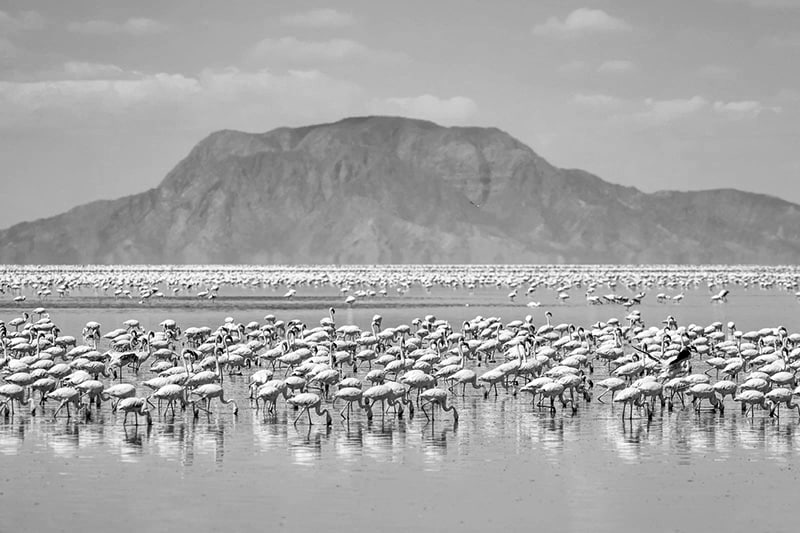Exploring the Habitat and Behavior of Greater Flamingos in Tanzania: Nature’s Pink Wonders
Introduction to the Greater Flamingo in Tanzania
Tanzania, a country known for its diverse wildlife and stunning landscapes, is home to one of nature’s most captivating creatures – the greater flamingo. These majestic birds, with their vibrant pink feathers and graceful movements, are a sight to behold. In this article, we will delve into the fascinating world of greater flamingos in Tanzania, uncovering their habitat, behavior, migration patterns, breeding habits, and their importance in the ecosystem.
Habitat of the Greater Flamingo in Tanzania
The greater flamingos in Tanzania are primarily found in the alkaline lakes and wetlands of the country. One of the most famous locations to spot these magnificent birds is Lake Natron, located in the northern part of Tanzania. This soda lake provides the perfect conditions for the greater flamingos to thrive, with its shallow waters and abundant food sources. The flamingos are also known to inhabit other lakes such as Lake Manyara and Lake Eyasi, as well as the coastal areas of Tanzania.
The alkaline lakes of Tanzania are rich in blue-green algae, which serves as the primary food source for the greater flamingo. These lakes also offer protection from predators like crocodiles and large mammals, making them an ideal habitat for these graceful birds. The vast expanse of the lakes provides ample space for the flamingos to forage, socialize, and engage in their unique feeding behaviors.
The behavior and feeding habits of the Greater Flamingo
Greater flamingos are known for their distinctive feeding habits, which involve filter-feeding on small organisms and algae in the water. These birds use their specialized bills to filter out food from the water, while their long legs help them wade through the shallow areas of the lakes. The flamingos often form large groups called colonies, where they work together to create a feeding frenzy, stirring up the water and making it easier to capture their prey.
The flamingos’ diet consists mainly of brine shrimp, small fish, and tiny crustaceans, which are abundant in the alkaline lakes of Tanzania. Their feeding behaviors not only help them obtain the necessary nutrients but also play a crucial role in the ecosystem by maintaining the balance of the lake’s food chain. The greater flamingos’ filtering action helps keep the water clean and clear, benefiting other aquatic organisms that rely on the lake’s resources.
Migration Patterns of the Greater Flamingo in Tanzania

The greater flamingos in Tanzania exhibit an intriguing migration pattern, with some individuals traveling vast distances to find suitable breeding grounds and food sources. These birds are known to migrate between different wetland areas within East Africa, including countries such as Kenya, Uganda, and Tanzania. The migration typically occurs in response to changes in water levels, food availability, and breeding conditions.
During the dry season, when the water levels in Tanzania’s alkaline lakes decrease, the flamingos may embark on long-distance journeys in search of more favorable conditions. They follow the rains and seek out shallow, freshwater lakes or coastal areas where they can find an abundance of food. The migration of the greater flamingos is a remarkable spectacle, as large flocks of these pink wonders take flight, creating a breathtaking display in the sky.
Breeding and Nesting Habits of the Greater Flamingo
Breeding is a crucial part of the greater flamingos’ life cycle, and Tanzania provides important breeding grounds for these birds. The alkaline lakes of the country offer the ideal conditions for the flamingos to build their nests and raise their young. The breeding season typically occurs during the wet season when the water levels in the lakes are higher, providing protection and easier access to food.
The greater flamingos are colonial breeders, meaning they nest in large groups or colonies. These colonies can consist of thousands of individuals, creating a cacophony of calls and a remarkable sight. The flamingos build their nests from mud, creating cone-shaped structures that rise above the water’s surface. Both male and female flamingos take turns incubating the eggs, which hatch after about a month.
Threats and Conservation Efforts for the Greater Flamingo in Tanzania
While the greater flamingos in Tanzania are a remarkable species, they face several threats to their survival. Habitat loss, pollution, and disturbance from human activities pose significant challenges for these birds. The development of industries and agriculture near their habitats can disrupt the fragile ecosystem on which the flamingos depend.
To protect the greater flamingos in Tanzania, conservation efforts are underway. Organizations and local communities are working together to raise awareness about the importance of preserving the wetland habitats and implementing sustainable practices. Strict regulations are in place to control human activities near the flamingos’ habitats, ensuring their long-term survival.
Tips for Spotting and Photographing the Greater Flamingo in Tanzania
If you’re planning to visit Tanzania and witness the beauty of the greater flamingos, here are some tips to enhance your experience:
- Research the best time to visit: Flamingo sightings are more common during the dry season, when water levels are lower and birds concentrate in specific areas.
- Bring binoculars and a good camera: Flamingos can be quite far from the shore, so having a pair of binoculars and a telephoto lens will help you get a closer look.
- Be patient and observe quietly: Flamingos can be skittish, so it’s essential to approach them slowly and quietly to avoid causing any disturbance.
- Respect their space: Keep a safe distance from the flamingos and avoid getting too close to their nesting areas. Remember that the birds’ well-being should always come first.
Interesting Facts about the Greater Flamingo in Tanzania
- The greater flamingo is the largest species of flamingo and can reach a height of up to 4.5 feet.
- The vibrant pink color of the flamingo’s feathers comes from the pigments in their diet, specifically the carotenoids found in the algae and crustaceans they consume.
- Flamingos are highly social birds and often engage in synchronized displays, such as group courtship rituals and “head-flagging” where they rapidly move their heads from side to side.
- The greater flamingo has a lifespan of around 20 to 30 years in the wild.
- Flamingos are excellent flyers, capable of reaching speeds of up to 35 miles per hour.
The Role of the Greater Flamingo in the Ecosystem of Tanzania
The greater flamingo plays a vital role in the ecosystem of Tanzania. Their feeding behaviors help regulate the populations of small organisms and algae in the lakes, preventing overgrowth and maintaining a healthy balance. By filtering the water, they improve its quality, benefiting other aquatic species. Additionally, the greater flamingos serve as an indicator species, reflecting the overall health of the wetland habitats and the surrounding environment.
Conclusion
The greater flamingos in Tanzania are not only nature’s pink wonders but also an integral part of the country’s diverse ecosystem. Their unique habitat, feeding habits, migration patterns, and breeding behaviors make them a fascinating species to study and admire. As visitors to Tanzania, it is our responsibility to appreciate and protect these magnificent birds, ensuring their presence for generations to come. So, the next time you find yourself near an alkaline lake in Tanzania, take a moment to marvel at the beauty of the greater flamingo and the intricate web of life they represent.
For more articles related to Wildlife in Tanzania (Animals), click here!

































